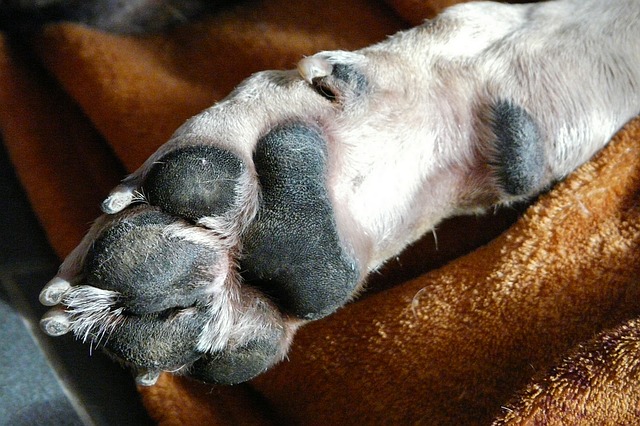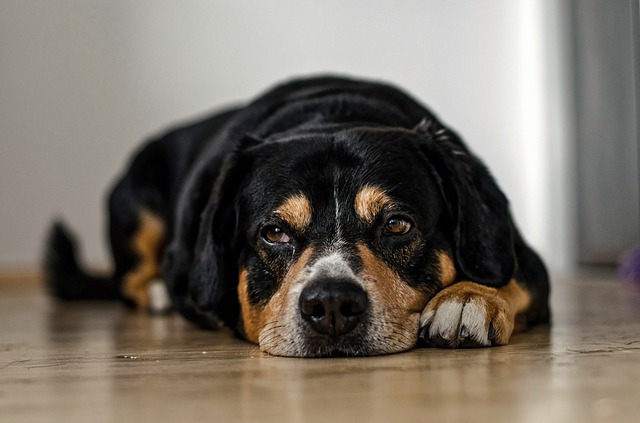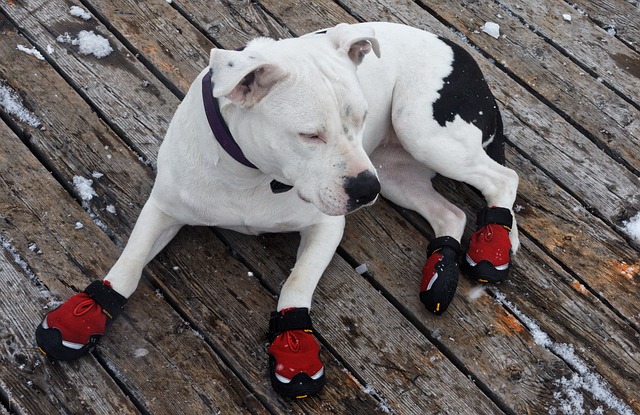A dog’s paw pads tend to go unnoticed in terms of upkeep, but they’re one of your pet’s most important physical features. They’re built tough, but there are certain conditions that cause paw pads to be painful. Paw pad hyperkeratosis is an example.
This is a type of skin condition where a dog develops especially dry, crusty, and sensitive skin on the bottom of their paws. It’s also called “hairy dog feet” because it can look like the dog is sprouting an unusual type of hair on the bottoms of their feet. If this sounds like something your pup has, here’s what you need to know.

What Exactly is Hyperkeratosis in Dogs?
When you break down the word “hyperkeratosis,” it’s not hard to figure out what it means. The prefix “hyper” refers to overstimulation, and “keratosis” comes from the word “keratin.” You most likely recognize that word from your shampoo bottle, and that’s a good place to start. Keratin is a type of fibrous protein used as one of the main ingredients in hair, claws, and the outer layer of skin. Dogs naturally produce their own supply of keratin, but hyperkeratosis means they produce much more than they need.
With too much keratin to go around, hyperkeratosis results in the dog growing a hard, crusty material over their paw pads. There are varying levels of severity, but most dog owners say it looks like their pup has a layer of extra-hard fur growing out of their paw pads. In especially bad cases, the paws can crack and become infected. There’s also nasal hyperkeratosis where the same condition presents itself on the dog’s nose.

What’s the Cause?
There are several possible causes for hyperkeratosis, and the most likely is genetics. Certain breeds including Dogues de Bordeaux, retrievers, and terriers are especially prone to developing this skin condition. If that’s the case and the dog’s parents passed on the genetic predisposition, symptoms usually appear by the time the dog is one year old.
Besides genetics, there are a few medical conditions where hyperkeratosis is a common symptom.
Leishmaniasis: This disease is spread by parasites most often carried by sandflies. It can affect the dog’s fur, skin, and abdominal organs. It can be treated with medication.
Pemphigus Foliaceus: Characterized by scaly blisters, this autoimmune disease is relatively common in dogs. Diagnosis requires a biopsy, but it can be treated with immunosuppressive medication.
Zinc Responsive Dermatosis: Dogs that are incapable of properly absorbing zinc suffer from crusted paw pads, stunted growth, diarrhea, and other symptoms. Taking regular zinc supplements can help.
Canine Distemper: Most dogs receive a vaccine for canine distemper when they’re puppies. In rare cases where dogs come down with the virus, hyperkeratosis can be a symptom.

How is it Treated?
There is no cure for canine hyperkeratosis. Young dogs might not show signs of it bothering them at first, but if left untreated, their “hairy paw pads,” can become extremely sensitive. It may be painful to walk or stand for too long a time, and traversing hard, hot, or cold surfaces can be especially difficult. It’s important to treat the condition to manage symptoms and keep dogs on their feet. Here are a few ways to do it.
1. Have the crust removed.
When the crusty shell of extra keratin continues to grow, your veterinarian might recommend having it removed. This should only be done by a professional and involves cutting the extra crust off the foot. Without that layer of crust, the dog is more comfortable, and walking is easier on their feet. Crust will need to be removed every few months.
2. Protect their paws with boots or socks.
The long walks your dog loves so much could actually be making their paws worse. You can protect them from the rough surface of the sidewalk or other hard ground by getting them their own booties and socks. Booties are great for dogs that love the outdoors, especially when it’s extra hot or extra cold outside. Socks with rubber grips on the bottom are also great for indoor use if you have tile or wood floors.

3. Take advantage of the healing properties of steam.
There’s a reason people love visiting the sauna. Steam has healing and moisturizing effects that can soften skin. You can create your own doggy sauna in your bathroom. Let the hot water in the tub run long enough to fill the room with steam. Don’t turn on the exhaust fan, and let your pup sit in the steam for as long as they’ll stand being cooped up in a small room.
4. Sooth paw pads with shea butter or other natural oils
The key to treating paw pad hyperkeratosis is keeping the paw pads supple and moisturized. But you can’t simply rub your personal lotion onto your dog’s feet. A lot of ingredients in regular lotion or petroleum jelly based products are harmful to dogs. Shea butter, however, is great for humans and their pets. It’s dog-safe, and it’s full of vitamins and natural fatty acids. It moisturizes paw pads while helping reduce inflammation. Here’s a balm that we use and recommend that contains shea butter and many other useful oils.
While potentially painful, dogs with hyperkeratosis are perfectly capable of living long, normal lives. It’s a condition that could affect their quality of life if you let it, but treating those crusty paws will take only a few minutes each day. If you suspect your dog has paw pad hyperkeratosis, talk to your vet about the best way to move forward with treatment.
These statements have not been evaluated by the Food and Drug Administration. This product is not intended to diagnose, treat, cure, or prevent any disease. The information on this website is not intended to replace a one-on-one relationship with a qualified healthcare professional.
Sources: Canine Journal, PetMd
via Whisker Therapy